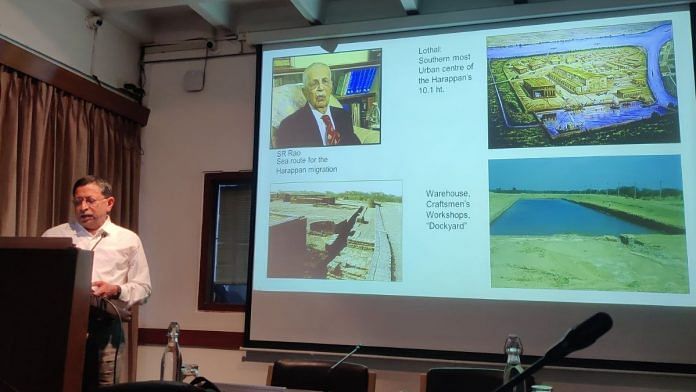New Delhi: It wasn’t the grand cities of Mohenjo-daro or the grid plans of Harappa that held the most tantalising clues to the Indus past, but a quiet scatter of potsherds in Gujarat. In these shards, found far from the civilisation’s northwestern heartland, lies a story of complex beginnings, cultural negotiations, and hybrid identities. Here, the Harappan world wasn’t simply transplanted. It was reimagined.
“We have this image of Harappan culture as a monolithic entity. But what we see in Gujarat is a much more dynamic and regionally diverse development. The Western Indian picture is quite different,” said P Ajithprasad, a guest professor at IIT Gandhinagar’s Archaeological Sciences Centre, during a recent talk exploring Gujarat’s role in the Harappan civilisation.
An evening at the India International Centre (IIC) on 4 April transformed into a journey through time as Ajithprasad unraveled Gujarat’s forgotten place in the Harappan world. Part of the History and Heritage: The Afterlife of Monuments series curated by historian Himanshu Prabha Ray and chaired by YS Rawat, Director-General of the Archaeological Survey of India, the talk offered more than just a historical overview, it reimagined the Harappan civilisation through the lens of its southern frontier.
Gujarat, often seen as a peripheral outpost to Harappa and Mohenjo-daro, emerged instead as a vibrant zone of cultural negotiation, innovation, and survival. With striking evidence from recent excavations, Ajithprasad revealed how this region was not merely influenced by the Harappan world but helped shape it, through distinctive ceramics, unique subsistence systems, and a remarkable ability to adapt to environmental challenges.
“It’s not just about what we find in the ground,” the professor declared to a captivated audience. “It’s about what those fragments tell us about people, their lives, their choices.”
Local traditions in a growing network
Long before the fully urbanised Harappan phase reached Gujarat, the region was alive with its own Chalcolithic cultures. Around 3200–2600 BCE, communities in north and central Gujarat were already experimenting with pottery styles and subsistence strategies that would later interact with and absorb Harappan influences. Rather than passive recipients of a larger civilisation’s overflow, these groups played an active role in shaping what would become Gujarat’s distinct Harappan character.
Ajithprasad highlighted three key regional ceramic traditions that predated classical Harappan traits in Gujarat: Anarta in north Gujarat, Padri along the Saurashtra coast, and Pre-Prabhas near Prabhas Patan in southern Saurashtra.
“We now have clear archaeological evidence of a fairly widespread presence of three regional Chalcolithic cultures in Gujarat which can be considered Early Harappan in terms of chronology, but culturally quite distinct from the so-called classical Harappan culture,” Ajithprasad said.
These early groups had their own ways of life. Their subsistence patterns show a reliance on both agriculture and pastoralism, with domesticated animals forming an important part of the economy. Sites like Loteshwar in north Gujarat revealed early occupation phases where people lived in pit dwellings, without any structural constructions, yet already displayed an evolving material culture.
“They were probably semi-nomadic pastoralists who came and camped at these sites seasonally,” Ajithprasad explained, referring to the Loteshwar findings. “Over time, their material culture became more permanent, suggesting a gradual settling down”.
These early communities set the stage for a dynamic interaction with incoming Harappan traits. As Harappan influence began filtering into Gujarat during the Mature phase, around 2600 BCE, it didn’t displace local traditions but merged with them in fascinating ways. The Harappanisation of Gujarat, in other words, was less about imposition and more about negotiation.
“The Harappans didn’t come and colonise Gujarat. What we see instead is a process of integration, where local communities adopted certain Harappan features, especially ceramics, but retained much of their own traditions,” Ajithprasad said.
Also read: What caused the rise and fall of Harappan civilisation? Studies debunk role of ‘river culture’
Fusion, frontier, and fluid identities
By the time of the Mature Harappan phase (2600–1900 BCE), Gujarat had become an active frontier of the Harappan world. This frontier was not a boundary, but a space of cultural fusion, one where urban Harappan traits mingled with local traditions to create something new. Settlements like Dholavira, Surkotada, and Lothal began to emerge, not as carbon copies of Mohenjo-daro or Harappa, but as regional adaptations, influenced as much by their geography as by their neighbours.
Ajithprasad said that the Classical Harappan ceramic tradition—characterised by red ware with black painted designs—was indeed present in Gujarat but often co-existed with indigenous styles like Anarta ware.
“At sites like Nagwada and Surkotada, Classical Harappan pottery is found alongside Anarta ware. There is no evidence of the former replacing the latter, which implies continued coexistence and interaction between communities,” he said.
This coexistence extended beyond pottery. Settlement layouts, burial practices, and even agricultural patterns reflect a blending of Harappan organisational traits with local adaptations. The spatial organisation of sites like Dholavira, with its unique water management systems and tiered city planning, shows both innovation and improvisation.
“What’s striking about Dholavira is how it adapted Harappan ideas to a semi-arid landscape,” Ajithprasad said. “They were clearly not just copying a model, they were reinventing it to suit their environment.”
Meanwhile, inland sites like Gola Dhoro in Kachchh and Shikarpur in Saurashtra reflected small but economically significant settlements that were likely plugged into the broader Harappan trade network. Even more interesting were the people living in the margins, those who continued their indigenous ways while selectively incorporating Harappan artefacts or techniques.
“It’s not a homogenous cultural landscape. You have core Harappan settlements, peripheral settlements, and in between, a mosaic of communities adopting different degrees of Harappan traits,” Ajithprasad said.
In this regional patchwork, Gujarat reveals itself not as a cultural outpost but as a zone of innovation and synthesis. The Harappan civilisation here wasn’t fading, it was transforming. What emerged in Gujarat was a hybrid civilisation, uniquely adapted and deeply rooted in both Harappan and local cultural soil.
(Edited by Aamaan Alam Khan)






